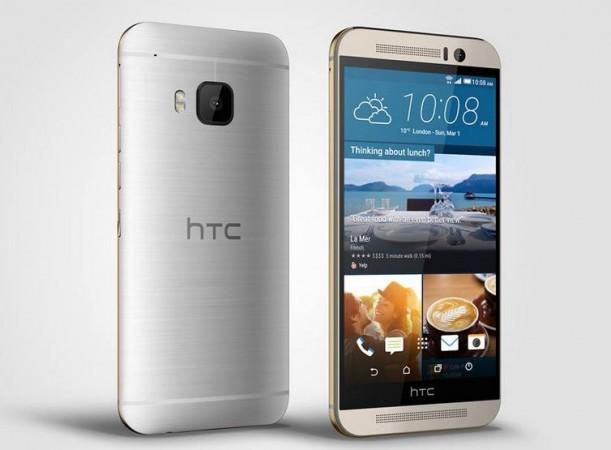
Taiwanese smartphone maker on Sunday (1 March) finally unveiled the 2015 flagship smartphone HTC One M9 at a glitzy event at Barcelona, which is hosting the Mobile World Congress 2015 (MWC) from 2 to 5 March.
Like its predecessor, HTC One M9 too comes with a metal body; what's interesting about the new phone is that it boasts of dual- tone metal uni-body design language (more on that discussed below), bump-in camera department, faster SoC (System on Chip), sumptuous RAM, high capacity battery and other improvements over One M8.
To get a clear perspective of the two HTC One siblings, we have done a quick specification rundown.
Design and Display:
Few months ago (October 2014, to be precise), the UK's prestigious gadget magazine T3 (Tomorrow's Technology Today) rated HTC One (M8) as the best smartphone of 2014. It noted that One M8 trumped more popular rivals- Apple and Samsung - to win the top honours. Even its predecessor One (M7) was named top smartphone in 2013.
HTC, in its bid to keep true to the One series' iconic design legacy, has come up with a more evolved and better One M9.
The One M9 boasts of dual- tone all-metal body design language in which the phone's rear is a silver-coated metal, whereas on the edges, it has gold-coated metal providing dual-metal finish.
In terms of display, the new phone sports the same 5.0-inch full HD Super LCD 3 screen with pixel density of 440 ppi (pixels per inch) seen in its predecessor.
Many fans might complain, why HTC has failed to incorporate QHD (2560x1440p), which has become an industry norm for flagship devices since mid-2014. But we would like to remind our readers the full HD, QHD screens, which we see in the phones are gimmicks that companies' use to market their products.
Many research studies have shown that the human eye cannot notice the difference in pixel density beyond HD (720x1280p) in the small confines of a smartphone screen; moreover a display with 2K resolution would have been a huge burden on the battery, draining power in no time if a high-resolution video is played even for a short time. So, HTC One M9 will certainly not disappoint fans while watching videos or seeing photos on the device.
Even control keys layout has undergone change in the new One M9.
Earlier models used to have Volume rockers and microSD card slot to the right, a Nano-SIM slot to the left and the power button on top.
However, in the new HTC One M9 phone, volume rockers and power switch have been placed at the right side edge, with SIM slot on top.
HTC One M8 body is made of metal (90-percent) and sports the same 5.0-inch full HD display on the front.
Processor, RAM and Storage:
The third generation HTC One ships with Qualcomm's latest Snapdragon 810 series SoC (System on Chip). It comes with Octa-core chipset housing Quad-core ARM® Cortex™ A57 and quad-core A53, and can clock a staggering 2.7GHz CPU speed.
It is worth noting that Snapdragon 810 is a 64-bit class chipset making HTC One M9 future proof, since most of the Android apps and games developed starting this year will be made using 64-bit source codes. Even older apps will be upgraded to the new standard.
HTC One M9 is backed by sumptuous 3GB RAM enough to run power-intensive 3D games and do multi-tasking, like running numerous apps simultaneously with less lag.
HTC One M8 houses 2GB RAM and comes with 16GB and 32GB storage options, with additional scope for expansion.
Camera:
In 2014, HTC for the first time introduced an additional camera sensor on the top of the main camera module to capture detailed information of a scene, enabling users to re-focus objects on the photos which already taken via UFocus application.
It housed a 4.0-UltraPixel dual-camera with dual-color LED flash (True Tone), 1/3'' sensor size, 2µm pixel size, HTC ImageChip 2, automatic simultaneous video and image recording, geo-tagging, face and smile detection, HDR, panorama and a 5.0-megapixel wide-angle front camera with BSI sensors, full HD video recording and HDR features.
Despite showing improvements in camera specifications over its predecessor, One M8 failed to impress critics.
Now, the company has incorporated a much better 20.0 megapixel camera (with Dual LED flash) on One M9. And on the front, it houses a ultra-pixel technology based (4.1-mp) snapper with wide-angle capture feature, which is certain to cheer selfie aficionados.
Mobile Operating System:
With the latest Android 5.0 Lollipop update already released to HTC One M7 and One M8, there is no added advantage in owning the new HTC One M9, apart from new Sense v7.0 UI interface. The company has even released photography-enhancing Eye Experience apps to the flagship phones.
[Also read: Android 5.0 Lollipop: Top Key Features of New Google Mobile OS]
Google's new Android 5.0 Lollipop OS comes with an overhauled design language Material design, bringing in interactive user-interface, visually appealing graphic design (with bold colours & typography), tactile surface, fluid animation features, replacement of Dalvik with ART as its default runtime and many more tweaks for performance enhancement.
Key specification of HTC One M9 and HTC One M8:
| Model | HTC One M9 | HTC One M8 |
| Display | 5.0-inch full HD screen with 1920x1080p resolutionPixel density: 440 plus ppi (pixels per inch) | 5.0-inch Super LCD 3 full HD (1920x1080p) screen with Corning Gorilla Glass 3 protectionPixel density: 440 ppi |
| OS | Android 5.0.2 Lollipop with custom UI Sense v7.0 | Android v4.4.2 KitKat OS with HTC Sense v6.0 UI(to get update for next two years) |
| Processor | 64-bit class 2.7GHz Snapdragon 810 series CPU ( Quad-core ARM® Cortex™ A57 and quad-core A53) | Qualcomm Snapdragon 801 series quad-core processor with 2.3GHz CPU speed (some select markets in Asia to be released with 2.5GHz CPU speed) |
| GPU | Adreno 420 | Adreno 330 |
| RAM | 3GB DDR4 | 2GB DDR3 RAM |
| Storage capacity | 32GB,expandable up to 128GB | 16GB/32GB, expandable up to 128GB |
| Camera | Main: 20.7-megapixel camera with f/2.2, 27.8mm lens, BSI sensor, digital stabilization and is capable of capturing 4k videoFront: 4.1- Ultrapixel camera with BSI sensor, f/2.0, 26.8mm lens and 1080p video recording | Main: 4.0-UltraPixel dual-camera with dual-color LED flash (True Tone), 1/3'' sensor size, 2µm pixel size, HTC ImageChip 2, automatic simultaneous video and image recording, geo-tagging, face and smile detection, HDR, panoramaFront: 5.0-megapixel wide-angle camera, full HD video recording, HDR |
| Battery | 2840 mAh;
|
2600 mAh (Li-Po, non-removable battery);
|
| Network | 3G & 4G-LTE in select regions | 3G & 4G-LTE Category 4 (50Mbps speed) |
| Add-ons | Nano-SIM slot, Aluminum based body, BoomSound, microSD card slot, Bluetooth v4.1, NFC, Wi-Fi (802.11 a / b / g / n / ac) | Metallic body (90-percent)Nano-SIM, Bluetooth v4.0 (with A2DP), Wi-Fi (802.11 a/b/g/n/ac), NFC, microUSB v2.0, MHL, microSD card slot, BoomSound audio system, Infrared blaster, |
| Dimensions | 144.6 x 69.7 x 9.61 mm | 146.4 x 70.6 x 9.4 mm |
| Weight | 157 g | 160 g |

















